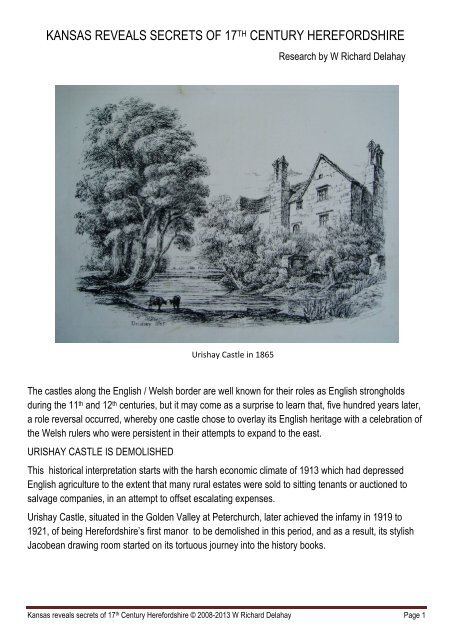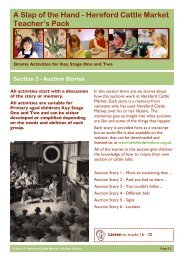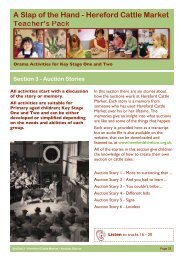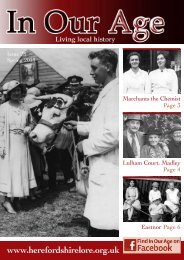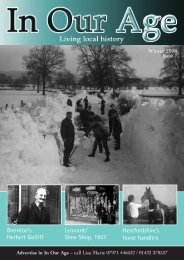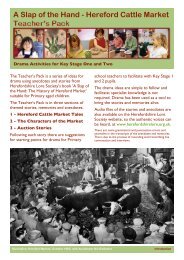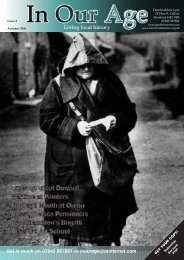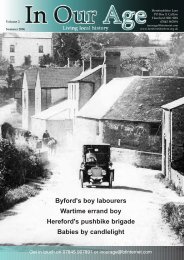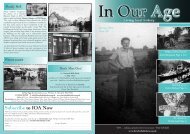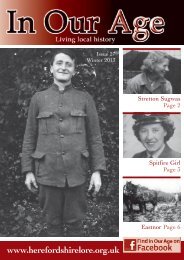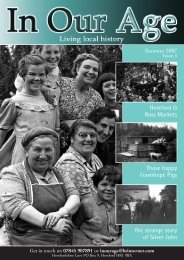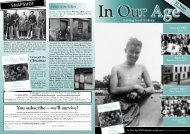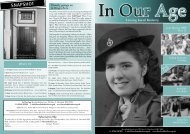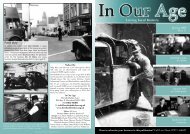To read more about this research please download this PDF.
To read more about this research please download this PDF.
To read more about this research please download this PDF.
You also want an ePaper? Increase the reach of your titles
YUMPU automatically turns print PDFs into web optimized ePapers that Google loves.
KANSAS REVEALS SECRETS OF 17 TH CENTURY HEREFORDSHIRE<br />
Research by W Richard Delahay<br />
Urishay Castle in 1865 <br />
The castles along the English / Welsh border are well known for their roles as English strongholds<br />
during the 11 th and 12 th centuries, but it may come as a surprise to learn that, five hundred years later,<br />
a role reversal occurred, whereby one castle chose to overlay its English heritage with a celebration of<br />
the Welsh rulers who were persistent in their attempts to expand to the east.<br />
URISHAY CASTLE IS DEMOLISHED<br />
This historical interpretation starts with the harsh economic climate of 1913 which had depressed<br />
English agriculture to the extent that many rural estates were sold to sitting tenants or auctioned to<br />
salvage companies, in an attempt to offset escalating expenses.<br />
Urishay Castle, situated in the Golden Valley at Peterchurch, later achieved the infamy in 1919 to<br />
1921, of being Herefordshire’s first manor to be demolished in <strong>this</strong> period, and as a result, its stylish<br />
Jacobean drawing room started on its tortuous journey into the history books.<br />
Kansas reveals secrets of 17 th Century Herefordshire © 2008-2013 W Richard Delahay Page 1
THE JACOBEAN PANELLED ROOM GOES ON DISPLAY<br />
Stained glass windows set high in the walls<br />
Carved over-mantle with pedestals and pilasters<br />
The oak panelled room, almost 20 feet square, complete with its doors, carved over-mantle and<br />
coloured glass windows, was re-erected in the Knightsbridge Halls, London, and offered for re-sale to<br />
a world-wide audience.<br />
Its first significant destination was to be Marshall Fields, the Chicago department store, where it was<br />
pressed into service as an authentic backdrop for the store’s display of antique furniture.<br />
Around <strong>this</strong> time, American museums were keen to show off “British history”, and after being in a<br />
prominent position in Marshall Fields for approximately 6 years, the drawing room was acquired by the<br />
Art Institute of Chicago, where it was on display as a Jacobean oak panelled room.<br />
THE WAR YEARS<br />
Pilaster detail<br />
Carved frieze and cornice<br />
By the mid 1930s, the enthusiastic aggregation of panelled rooms from Europe had saturated the<br />
American museum environment such that a measure of off-loading became inevitable, and the drawing<br />
room from Urishay Castle later found itself preserved in crates in the basement of the Art Institute of<br />
Chicago.<br />
There the Herefordshire treasure languished during World War 2 and its 15 year aftermath, whilst<br />
market forces diverted collector’s interests towards <strong>more</strong> immediate needs.<br />
Kansas reveals secrets of 17 th Century Herefordshire © 2008-2013 W Richard Delahay Page 2
RESURRECTION<br />
In 1962, the drawing room re-emerged from its storage crates, having been purchased by benefactor<br />
Helen Spencer for donation to Baker University, Kansas. This generous action was organised to<br />
coincide with the re-housing of the William Quayle Rare Bible collection, which also formed part of the<br />
University’s collection. A custom-built extension was added to the new Spencer wing and the Urishay<br />
panelled room was installed in a temperature controlled environment adjacent to the Bible display.<br />
RE-DISCOVERY AND REVELATION<br />
It was in 2007 on a visit to Kansas to view the exhibit from the 17 th century manor house, that I hugged<br />
the walls in search of “voices from the past”. Instead of voices, the stained glass windows set high in<br />
the oak walls presented a puzzle awaiting interpretation.<br />
Of the six coats of arms so beautifully presented, only one was immediately recognisable, that being<br />
the pointed red sun of the 12 th Century Lord of the Manor John de la Hay.<br />
Research revealed that the other five mystery coats of arms celebrated the Welsh rulers and their<br />
homelands, who had led their clans to battle against the English throughout the Welsh Marches in<br />
earlier centuries.<br />
They were Deheubarth (An area in medieval South Wales), Lestyn ap Gwryant (Welsh ruler of<br />
Morganwg), Llywelyn (the Royal House of Gwynedd), Gruffydd ap Cynan (Aberffraw dynasty), and<br />
Owain Gwynedd (Grandfather to Owain Glyndwr, Llywelyn the Great).<br />
Other visuals, such as those associated with nearby influential manors in Ewyas Lacy and Snodhill,<br />
were conspicuous by their absence, as were the composite quadrants that typically signified family<br />
marriages.<br />
The five coats of arms on display clearly acclaimed the Welsh leaders of the 11 th , 12 th and 13 th<br />
centuries.<br />
Kansas reveals secrets of 17 th Century Herefordshire © 2008-2013 W Richard Delahay Page 3
But the existence of these Welsh coats of arms, displayed so prominently in the Urishay Room,<br />
required deeper examination if an explanation for their presence was to be found.<br />
Two relevant discoveries emerged;<br />
…………firstly, Urishay Castle was rebuilt as a manor house in the 17 th century and would have<br />
reflected the Lord of the Manor’s desire to make a statement <strong>about</strong> his politics, heritage and position in<br />
society.<br />
…………secondly, Lord of the Manor of the Urishay Estate at <strong>this</strong> time, Thomas Delahay, was of<br />
predominantly Welsh descent and the family held a handful of estates in the vicinity of the Welsh<br />
Marches.<br />
We are therefore led to the conclusion that the stained glass windows featuring in the rebuild were a<br />
celebration of Welsh history, Welsh command of Urishay, and Welsh aspirations for the future.<br />
And so Urishay Castle, originally one in the north / south border line of English strongholds, came to<br />
demonstrate a Welsh allegiance. Was <strong>this</strong> a controversial statement in 17 th Century Herefordshire ?<br />
Quite possibly it was, although the subtle visuals displayed in the drawing room would have ensured<br />
the message reached only those who were invited in.<br />
Welsh domination of the Urishay Estate continued through the 17 th , 18 th and most of the 19 th centuries.<br />
Currently, the Urishay Room is used for lectures and choral events, and is said to “glow with pride”<br />
when it is filled with an appreciative audience.<br />
Being adjacent the Quayle Rare Bible collection, many of these events in 2011 were associated with<br />
the 400 th anniversary of the 1611 publication of the King James version of the Bible.<br />
Baker University, Kansas, is to be applauded for the care and attention lavished on the Urishay Room,<br />
ensuring its preservation for the pleasure of future generations.<br />
_________ooooOOoooo_________<br />
© 2008-2013 (R 4) W Richard Delahay<br />
The author dedicates <strong>this</strong> article to Alice, Lucy and Thomas, who are<br />
17 th generation descendants in a line that can be traced to the 13 th Century.<br />
Acknowledgements<br />
The illustration of Urishay Castle is by Lady Francis Vernon Harcourt in 1865. Ref: A History of the Castles of<br />
Herefordshire and their Lords, by the Rev Charles Robinson, M.A. MDCCCLXIX.<br />
Photographs of the interior of the Jacobean Room are with permission of Quayle Bible Collection,<br />
Baldwin City, KS, USA.<br />
__________ooooOOoooo__________<br />
Kansas reveals secrets of 17 th Century Herefordshire © 2008-2013 W Richard Delahay Page 4


